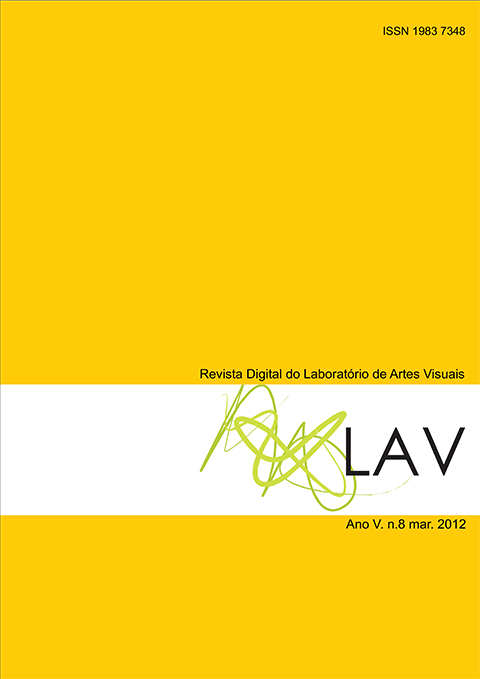Image on the wall, a game in the hammock reflection on images and pixelated daily life
DOI:
https://doi.org/10.5902/198373484093Keywords:
Techniques images, Dazzling, Game, Vilém FlusserAbstract
In this paper, we propose a reflection about the dialogues articulated on projections and representations of the telematics networks users imaginary. The discussion begins with the involvement of these users with the techniques images and with the proximity established by technological devices. In processes of enchantment and dazzling within the universe formatted by null-dimensional pixels, projections represent and simulate the natural world through imaginary surfaces. This universe composed entirely of intangible information, where the binary codes organize the pixels to form images on screens where there are no dimensions. It is in this null-dimensional space that has arises the condition for the affair between the man and the technological devices. In this game, the participant‟s role is to act as programmed by the algorithms of these environments. To observe these relationships, we have done the analysis of the artistic performance Casa_Comigo, based on some lectures of Vilém Flusser. The artistic act consisted of a site and projected images inside the home of the artist-author. The result of the analysis led to the central question of this article: the techniques images are effective ways to establish dialogic relations between people?Downloads
References
BAUMAN, Zygmunt. Identidade: entrevista a Benedetto Vecchi/Zygmunt Bauman. Rio de Janeiro: Jorge Zahar Ed., 2005.
BREA, José Luis. La crítica em la era del capitalismo eletrônico. Disponível em: http://www.agenciacritica.net/criticaeck/ . Acessado em 27/02/2010.
CIRINO, Renato. Casa_Comigo. Performance artística. Programa de Pós-Graduação em Arte e Cultura Visual. UFG: Goiânia, 2011.
DOS SANTOS, Laymert G. Cultura digital.br / organização Rodrigo Savazoni, Sergio Cohn. - Rio de Janeiro: Beco do Azougue, 2009, pag.284-293. Disponível on-line em: http://www.cultura.gov.br/site/wp-content/uploads/2009/09/cultura-digital-br.pdf.
DUNCUM, Paul. Uma história da estética popular. Palestra. Transcrição: Renato Cirino. Programa de Pós-Graduação em Arte e Cultura Visual. UFG:Goiânia, 2011.
FLUSSER, Vílem. O universo das imagens técnicas. São Paulo: Annablume, 2008.
HALL, Stuart. A identidade cultural na pós-modernidade. Rio de Janeiro: DP&A, 2011.
HERNÁNDEZ, Fernando. Catadores da Cultura Visual: transformando fragmentos em nova narrativa educacional. Porto Alegre: Mediação, 2007.
MARTINS, Alice Fátima. Imagens técnicas: questão de vida ou morte no vazio sem dimensões. In: Revista VIS (UnB). Brasília: ED. BRASIL, 2009, v. 8, n. 1, p.121-127.
MARTINS, Alice Fátima. Da educação artística à educação para a cultura visual: revendo percursos, refazendo pontos, puxando alguns fios dessa meada. In: Educação na cultura visual: narrativas de ensino e pesquisa / Raimundo Martins e Irene Tourinho (orgs). Santa Maria: Ed. da UFMS,2009, p.101-117.
MCLUHAN, Marshal; FIORE, Quentin. O meio é a mensagem. Rio de Janeiro: Imã Editorial, 2011.
MIRZOEFF, Nicholas. An Introdution to Visual Culture. Londres/Nova York: Routledge, 1999.
MOXEY, Keith. Estética de la cultura visual em el momento de la globalización. In: Estudios Visuales: la epistemologia de la visualidade em la era de la globalozación / José Luis Brea (org). Madrid: Akal Ediciones, 2005, p.27-37.
ROCHA, Cleomar. Deslumbramentos e encantamentos: estratégias tecnológicas das interfaces computacionais. In: Revista Zona Digital. Ano I, n. 1. Disponível em: http://bit.ly/sB3hKa. Acesso em: 20/09/2011.
TOURINHO, Irene; MARTINS, Raimundo. Circunstâncias e ingerências da cultura visual. In: Educação na cultura visual: conceitos e contextos / Raimundo Martins e Irene Tourinho (orgs). Santa Maria: Ed. da UFMS,2011, p.51-68.






